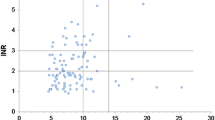Abstract
Background
Activated Factor XII (XIIa) is believed to participate in a number of pathophysiological processes including inflammation, thrombosis and fibrinolysis. Increasing XIIa levels following thrombolytic therapy have previously been reported. In contrast to other thrombolytics, tenecteplase (TNK-tpa) does not show paradoxical thrombin activation, indicating a lower procoagulant effect of this fibrin-selective thrombolytic agent. Recent research has demonstrated that in-vivo XIIa exists in a number of different types, and the aim of this study was to investigate plasma variations of different types of XIIa following thrombolytic treatment with TNK-tpa.
Methods
Citrated blood samples were obtained from 34 patients admitted with acute ST-elevation myocardial infarction (STEMI) treated with TNK-tpa. Samples were taken immediately prior to treatment, 30–90 min after and 4 days post-treatment. XIIa measurements were performed using 2 ELISA assays designed to preferentially measure different types of XIIa; XIIaA and XIIaR. Both assays utilised a monoclonal antibody 2/215, which is highly specific for XIIa, as the solid phase capture antibody. The assay for XIIaA used a conjugate based on a polyclonal antibody against the entire XIIa molecule, whilst the assay for XIIaR incorporated a reagent to release otherwise unavailable XIIa and used a conjugate based on a monoclonal antibody against β-XIIa.
Results
Changes in plasma XIIaA concentration as a result of therapy were more evident than changes in XIIaR concentration. XIIaA showed a significant increase from 67.1 (49.0–84.4) pM to 97.8 (75.5–133.1) pM [median and 25 and 75% percentiles] in the 30–90 min sample (P < 0.001), returning to pre-intervention levels 61.5 (47.5–81.0) pM by day 4. In contrast, no significant change in XIIaR concentration was observed following thrombolytic therapy with TNK-tpa.
Conclusion
In patients admitted with STEMI, thrombolytic therapy with TNK-tpa resulted in a significant short-lasting increase in specific types of XIIa (namely XIIaA), whereas other types of XIIa (XIIaR) were largely unaffected by this intervention.


Similar content being viewed by others
References
Silber S, Albertsson P, Aviles FF et al (2005) Guidelines for percutaneous coronary interventions, The task force for percutaneous coronary interventions of the European Society of Cardiology. Eur Heart J 26:804–847
Keeley EC, Boura JA, Grines CL et al (2003) Primary angioplasty versus intravenous thrombolytic therapy for acute myocardial infarction: a quantitative review of 23 randomised trials. Lancet 361:13–20
Merlini PA, Cugno M, Rossi ML et al (2004) Activation of the contact system and inflammation after thrombolytic therapy in patients with acute myocardial infarction. Am J Cardiol 93:822–825
Hoffmeister HM, Szabo S, Helber U, Seipel L (2001) The thrombolytic paradox. Thromb Res 103:51–55
Szabo S, Letsch R, Ehlers R et al (2002) Absence of paradoxical thrombin activation by fibrin-specific thrombolytics in acute myocardial infarction. Comparison of single-bolus tenecteplase and front-loaded alteplase. Thromb Res 106:113–195
Latacha MP, Schaiff WT, Eisenberg PR, Abendschein DR (2004) FXII-dependent increases in thrombin activity induce carboxypeptidase-mediated attenuation of pharmacological fibrinolysis. J Thromb Haemost 2:128–134
Fujikawa K, McMullen BA (1983) Amino acid sequence of human β-factor XIIa. J Biol Chem 258:10924–10933
Mc Mullen BA, Fujikawa K (1985) Amino acid sequence of the heavy chain of human α-factor XIIa (activated Hageman factor). J Biol Chem 260:5328–5341
Pritchard D, Polwart R (2005) In-vivo, activated factor XII exists in multiple forms, but predominantly as a 53 kD Species. J Thromb Haemost Suppl.1:1821
Esnouf MP, Burgess AI, Dodds AW, Sarphie AF, Miller GJ (2000) A monoclonal antibody raised against human β-factor XIIa which also recognizes β-factor XIIa but not factor XII or complexes of factor XIIa with C1-esterase inhibitor. Thromb Haemost 83:874–881
Grundt H, Nilsen DW, Hetland O, Valente E, Fagertun HE (2004) Activated factor 12 (XIIa) predicts recurrent coronary events after an acute myocardial infarction. Am Heart J 147:260–266
Cugno M, Cicardi M, Agostoni A (1994) Activation of the contact system and fibrinolysis in autoimmune aquired angioedema; a rationale for prophylactic use of tranexamic acid. J Allergy Clin Immunol 93:870–876
Agostoni A, Gardinali M, Frangi D et al (1994) Activation of the complement and kinin system after thrombolytic therapy in patients with acute myocardial infartion. Circulation 90:2666–2670
Hoffmeister HM, Szabo S, Kastner C et al (1998) Thrombolytic therapy in acute myocardial infarction: comparison of procoagulant effect of streptokinase and alteplase regimen with focus on the kallikrein system, and plasmin. Circulation 98:2527–2533
Eisenberg PR, Sherman LA, Jaffe AD (1987) Paradoxic elevation of fibrinopeptide A after streptokinase; evidence for continued thrombosis despite fibrinolysis. J Am Coll Cardiol 10:527–529
Owen J, Friedman KD, Grossman BA, Wilkins C, Berke AD, Powers ER (1988) Fibrinolytic therapy with tissue-type plasminogen activator or streptokinase induce transient thrombin activity. Blood 72:616–620
Merlini PA, Bauer KA, Oltrona L et al (1995) Thrombin generation and activity during thrombolysis and concominant heparin therapy in patients with acute myocardial infarction. J Am Coll Cardiol 25:203–208
Garabedian HD, Gold HK (1992) Coronary thrombolysis, conjunctive heparin infusion and the effect on systemic thrombin activity. Circulation 85:1205–1207
Pixley RA, Casselo A, De La Caneda RA, Kaufman N, Colman RW (1991) Effect of Heparin on the activation of Factor XII and the contact system in plasma. Thromb Haemaost 66:540–547
Fuhrer G, Gallimore MJ, Heller W, Hoffmeister HE (1990) FXII. Blut 61:258–266
Hojima Y, Cochrane CG, Wiggins RC, Austen KF, Stevens R (1984) In vitro activation of the contact (Hageman Factor) system of the plasma by heparin and chondroitin sulphate. E Blood 63:1453–1459
Pönitz V, Pritchard D, Grundt H, Mehus MB, Nilsen D (2005) Specific types of plasma activated Factor XII increase following percutaneous coronary intervention (PCI). J Thromb Haemost. Suppl 1:1736
Van de Werf F, Barron HV, Armstrong PV et al (2001) Incidence and predictors of bleeding events after fibrinolytic therapy with fibrin-specific agents: a comparison of TNK-tPA and rt-PA. Eur Heart J 22:2221–2223
Author information
Authors and Affiliations
Corresponding author
Rights and permissions
About this article
Cite this article
Pönitz, V., Pritchard, D., Grundt, H. et al. Specific types of activated Factor XII increase following thrombolytic therapy with tenecteplase. J Thromb Thrombolysis 22, 199–203 (2006). https://doi.org/10.1007/s11239-006-9031-6
Published:
Issue Date:
DOI: https://doi.org/10.1007/s11239-006-9031-6




